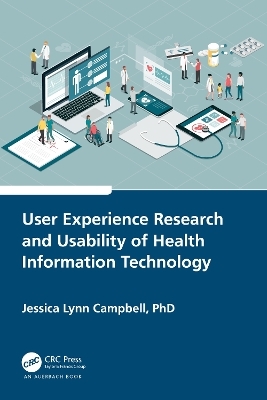
User Experience Research and Usability of Health Information Technology
Auerbach (Verlag)
978-1-032-16276-8 (ISBN)
Health information technology (HIT) is a critical component of the modern healthcare system. Yet to be effective and safely implemented in healthcare organizations and physicians and patients’ lives, it must be usable and useful. User Experience (UX) research is required throughout the full system design lifecycle of HIT products, which involve a user-centered and human- centered approach. This book discusses UX research frameworks, study designs, methods, data-analysis techniques, and a variety of data collection instruments and tools that can be used to conduct UX research in the healthcare space, all of which involve HIT and digital health. This book is for academics and scholars to be used to design studies for graduate dissertation work, in independent research, or as a textbook for UX/usability courses in health informatics or related health information and communication courses. This book is also useful for UX practitioners because it provides guidance on how to design a user research or usability study and focuses on leveraging a mixed- methods approach, including step-by-step by instructions and best practices for conducting:
Field studies
Interviews
Focus groups
Diary studies
Surveys
Heuristic evaluation
Cognitive walkthrough
Think aloud
A plethora of standardized surveys and retrospective questionnaires (SUS, Post-study System Usability Questionnaire (PSSUQ)) are also included. UX researchers and healthcare professionals will gain an understanding of how to design a rigorous, yet feasible study that generates useful insights to inform the design of usable HIT. Everything from consent forms to how many participants to include in a usability study has been covered in this book. The author encourages user-centered design (UCD), mixed-methods, and collaboration amongst interdisciplinary teams. Knowledge from many inter-related disciplines, like psychology, technical communication (TC), and human-computer interaction (HCI), together with experiential knowledge from experts is offered throughout the text.
Jessica Lynn Campbell has a PhD in Philosophy, and a master’s degree in English—Technical Communication, both of which she earned from the University of Central Florida (UCF). She is an experienced, expert UX researcher and designer, and technical communication practitioner, having held various roles in the healthcare and health informatics space creating content, engaging in digital marketing, and performing UX research for product and service development. Simultaneously with her industry career, Jessica holds an educator role. As a professor of English, she teaches several technical communication and UX courses. Her expertise and research interests intersect the technical communication, HCI, and UX disciplines where she focuses on the usability of health information technology (HIT) and leveraging user- centered design (UCD) and equity design to research and design HIT for various audiences. She has experience conducting mixed- method studies, including both quantitative and qualitative methods in investigations of the usability of telemedicine and similar digital health interventions. In addition to her research interest in the healthcare space, Jessica’s scholarly and academic interests include a broad scope of technical and professional communication (TPC) pedagogy, particularly exploring the engagement of students in social justice work, solving wicked problems, and improving digital literacy. She is curious, eager to collaborate, and contributes to the TPC community to continue to expand the TPC discipline.
1. Introduction. 2. Definitions: Usability, UX, and UCD. 3. Audience Analysis and Usability Determinants. 4. Quantitative and Qualitative Methods. 5. Mixed-Methods Study Design and Rigor. 6. Content Analysis. 7. Discovery UX Research Studies. 8. Usability Inspection Methods. 9. Quantitative Usability Testing Methods and Metrics. 10. Post-Study Surveys and Retrospective Questionnaires. 11. Conclusion. References. Appendix A. Sample Informed Consent Form. Appendix B. System Usability Scale. Appendix C. Quick Reference Sheet for Study Sample Sizes for Common UX Research.
| Erscheinungsdatum | 06.02.2024 |
|---|---|
| Zusatzinfo | 18 Tables, black and white; 6 Line drawings, black and white; 6 Illustrations, black and white |
| Verlagsort | London |
| Sprache | englisch |
| Maße | 156 x 234 mm |
| Gewicht | 430 g |
| Themenwelt | Mathematik / Informatik ► Informatik ► Software Entwicklung |
| Mathematik / Informatik ► Informatik ► Theorie / Studium | |
| Studium ► Querschnittsbereiche ► Epidemiologie / Med. Biometrie | |
| ISBN-10 | 1-032-16276-7 / 1032162767 |
| ISBN-13 | 978-1-032-16276-8 / 9781032162768 |
| Zustand | Neuware |
| Haben Sie eine Frage zum Produkt? |
aus dem Bereich


